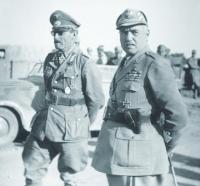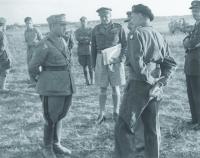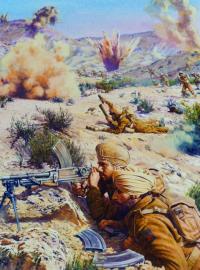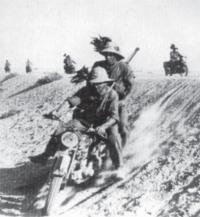
(l)Baron Kurt von Leibenstein, commander 164th Light Infantry Division and (r)Giovanni Messe, commander Italian 1st Army.

Marshal Giovanni Messe, cmdr. First Italian Army, presents himself to British Eighth Army Cmdr Gen. Bernard Law Montgomery, rt. foreground (hands clasped behind back); and Sir Bernard Freyberg (ctr., in shorts w/ file in hand).

Sikhs of the Fourth Indian Division assault the Mareth Line.

Elite Bersaglieri
This week, 70 years ago, the Allies were in the process of rounding up and capturing more than a quarter million Axis soldiers remaining in the French colony of Tunisia.
On February 23rd, Field Marshal Erwin Rommel had been given command of the newly created Armeegruppe Afrika, consisting of the, also newly created, 5th Panzerarmee commanded by Hans-Jürgin von Arnim and the Italian 1st Army, formerly, Deutsch-Italiensche Panzerarmee, (RommelÙs old command) under the command of Giovanni Messe - who was the best Italian army commander. The purpose of these new formations was an attempt to maintain a toehold in North Africa.
On March 6, the Italian First Army attacked General Bernard L. MontgomeryÙs British 8th Army at Médénine. Médénine, which today has a population of 60,000, is located in the southeastern part of Tunisia, 48 miles south of the port of Gabés. The attack was launched, at 6:00 A.M. by the Deutsches Afrikakorps, commanded by Hans Cramer (who would be the famed corpsÙ last commander), together with Baron Frederick von BroichÙs 10th Panzerdivisione from the 5th Panzerarmee. Deutsches Afrikakorps included Willibald BorowitzÙ 15th and Hans-George HildebrandtÙs 21st Panzerdivisiones and the 90th and 164th Light Infantry Divisions, commanded by Count Theodor von Sponeck and Baron Kurt von Leibenstein. But Monty was ready. He had been informed of the attack by information obtained through the folks at Bletchley Park, who had cracked the GermansÙ Enigma code. He had grouped his artillery to counter the German armor. That is what General MesseÙs tanks faced, and after a day, the Axis had lost 50 and called it quits. General MesseÙs army then retired behind the Mareth Line.
Field Marshal Rommel noted that, "This is the beginning of the end in Tunisia for the Axis forces." He could see that the British First and Eighth Armies had supplies pouring in, while his Armeegruppe Afrika, dependent on supplies transported across a Mediterranean Sea ruled by the Allied navies under skies controlled by Allied air forces, was in the clutch of a powerful boa constrictor, squeezing it ever tighter. For example, the Axis calculated that the Armeegruppe needed 140,000 tons of supplies per month. In March it received 29,000 tons. Meanwhile, the Americans, alone, received 400,000 tons that month.
On March 9, the Field Marshal flew to the Fatherland to advocate the evacuation of the Axis forces. He was harshly chastised, by der Führer, for leaving his post without permission, and placed on, much needed, medical leave. He would never return to Africa. General von Arnim took command of Armeegruppe Afrika, and was informed by the Italian Commando Supremo that, "...the task of the Armeegruppe is to hold its ground in Tunisia . . . the Mareth Zone is to be defended to the last." General von Arnim was succeeded as commander of 5th Panzerarmee by Gustav von Värst.
On March 19, General MontgomeryÙs 8th Army began its assault on the Mareth Line, defended by General MesseÙs First Italian Army. The Mareth Line had been constructed by the French to protect Tunisia from the Italians in neighboring Libya. It extended 22 miles from the coast to the mountains in the interior of eastern Tunisia. Prior to the assault, Commonwealth artillery delivered 20,000 rounds on the coastal sector, being defended by Nino SozzaniÙs under strength Giovani Fascisti Division and 15,000 rounds on Count von SponeckÙs equally under strength 90th Light Infantry Division. William Havelock RamsdenÙs Northumbrian Infantry Division launched a frontal assault while the New Zealand 2nd Division, still commanded by Sir Bernard Freyberg, went around the left. The left hook broke through on March 27th forcing the 1st Italian Army to withdraw 37 miles to the north to a line at Akarit. Gavino Pizzolato, commander of La Spezia Airborne Division was killed that day, while 7000 Axis soldiers were captured defending the Mareth Line. General Pizzolato was replaced by Arturo Scattini.
Allied forces were aggregated under the command of British General Sir Harold R. Alexander, as the Eighteenth Army Group, which included General MontgomeryÙs Eighth Army and Sir Kenneth A.N. AndersonÙs First Army. General AndersonÙs First Army included Sir Charles W. AllfreyÙs V and Sir John CrockerÙs IX British Corps, the II American Corps, commanded by Omar Bradley, and Lt. General Marie-Louis KoëltzÙ French XIX Corps.
General Messe deployed the following to defend the Akarit Line, north of Gabés: XX Italian Motorized Corps, commanded by Taddeo Orlando; Paolo BerardiÙs XXI Italian Infantry Corps; and in reserve, General BorowitzÙ 15th Panzerdivision, although it could only field about 10 tanks. General OrlandoÙs XX Corps included Francisco La FerlaÙs Trieste, General SozzaniÙs Giovani Fascisti and Count von SponeckÙs 90th Light Divisions. General BerardiÙs XXI Corps included General ScattiniÙs La Spezia Airborne, Giuseppe FalugiÙs Pistoia and Baron von LeibensteinÙs 164th Light Divisions.
On April 6, after a 1000 gun barrage, Monty again launched General RamsdenÙs Northumbrian Division and General FreybergÙs New Zealand Division, together with Douglas WimberleyÙs Highland Division and Francis TuckerÙs 4th Indian Division against General MesseÙs line. Outnumbered and outgunned, and with supplies running low, after a day, the Axis retreated again. This time, General MesseÙs army fell back 150 miles to a position at Enfidaville, 47 miles from Tunis. Now known as Enfida, it has a population of 10,000. MontyÙs Eighth and General AndersonÙs First Armies finally made contact, closing the ring around Armeegruppe Afrika, south of Tunis, on April 10, 1943.
At a meeting in Salzburg, the German Führer, on April 7, assured that, "With your help, Duce, my troops will make Tunis the ‘Verdun of the Mediterranean!Ù" On April 25, his Armeegruppe commander, General von Arnim, concluded that, "...even without the Allied offensive, I should have had to capitulate by June 1st at the latest, because we had no more to eat."
Tunis and Bizerte were captured 0n May 7. Tunis, the capital of Tunisia, with a current population of 725,000, was captured by Commonwealth troops. The American Ninth Division, commanded by Major-General M.S. Eddy, captured the 3000-year-old port of Bizerte. It is the northernmost city in Africa and today has a population of 230,000. The Americans then left Bizerte, so that the French could make their grand entrance, the next day. The G.I.s quickly composed a doggerel about "Dirty Gerty From Bizerte."
At 9:30 A.M., on May 9, General von Värst reported to General von Arnim that, "...our armor and our artillery have been destroyed. Without ammunition and fuel. We shall fight to the last." At 10:00 A.M., General von VärstÙs emissaries reached 1st Armored DivisionÙs commander General Ernest N. HarmonÙs headquarters to request an armistice. Second CorpsÙ commander, General Bradley, instructed General Harmon that, "...the terms of surrender are unconditional." At noon, those terms were accepted.
General von Arnim surrendered to General Allfrey on May 12. That same day, the Italian Duce promoted General Messe to Marshal, obviously inspired by the German FührerÙs promotion of General Paulus to Field Marshal, at Stalingrad, in the hope that he, unlike Paulus, would not surrender. The result was the same. The new Marshal designated his Chief-of-Staff, General Giuseppe Mancinelli, to negotiate surrender to the Eighth Army, rather than the First Army, because the French XIX Corps was a part of First Army and the Marshal did not want to risk surrendering his army to the French! Marshal Messe surrendered, together with the remnants of the First Italian Army, the next day to General FreybergÙs New Zealanders.
When General von Arnim surrendered, he expected to be met by his opposite number. When this did not occur, he requested an audience with Supreme Allied Commander Dwight D. Eisenhower. The American general refused. He did, however, get to visit the U.S., as he was held in a POW camp, in Mississippi, until his release in 1947.
Almost 275,000 battle-hardened German and Italian veterans had marched into captivity, most of whom were shipped to P.O.W. camps in the U.S. These soldiers, together with those lost in the previous four months, and their equipment, could have been better used to defend Sicily, or to relieve Stalingrad. The cost to the Allies had been 70,000 casualties.
A Victory Parade was held at noon on May 20, 1943 on Avenue Maréchal Galliéni in Tunis, but French soldiers loyal to General Charles de Gaulle refused to march with those loyal to General Henri Honoré Giraud. The British were disgusted with both, saying, "French! They make a lot of bloody noise, now, when itÙs all over. Never saw any of ‘em anywhere near the Jerries [Germans]!"
NEXT WEEK: DAMBUSTERS!
Mr. Wimbrow writes from Ocean City, Maryland, where he practices law representing those persons accused of criminal and traffic offenses, and those persons who have suffered a personal injury through no fault of their own. Mr. Wimbrow can be contacted at
wimbrowlaw@gmail.com



